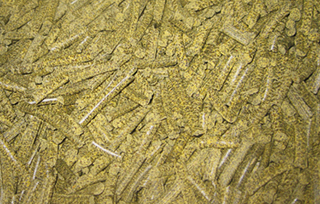Biodiesel
From the field to the tank
Biodiesel is a biogenic energy source, which is produced from vegetable and animal oil. Fresh vegetable oils (such as rapeseed oil, sunflower oil, soy bean oil, palm oil), used cooking oil and butchering fat are used as feedstock. Depending on raw material and energy content 1 litre of biodiesel can substitute 0.91 litre of fossil diesel fuel.
After harvesting the ripe oil seed, the oil is obtained by pressing or extraction, whereas the press residues, also referred to as presscake, can be used as feed. The obtained vegetable oil is converted during a chemical process called transesterification into fatty acid methyl ester (which is equal to biodiesel). For this production step the vegetable oil is mixed with about 10% of methanol together with a catalyst. As a by-product of the whole production chain both press cake and glycerine are produced. If the glycerine is further processed it can be utilized in the pharmaceutical industry. The generation of biodiesel made from residues follows the same concept as the catalytic esterification and transesterification.
Regardless the feedstock used for biodiesel production, the end-product is bound to the norm EN14214 from the European Union. Therefore the properties of biodiesel are similar to fossil diesel fuel. If a car manufacturer does not release the permission to use pure biodiesel, adaptions have to be made at the vehicle aggregate. This is not necessary for admixtures to fossil diesel, because the amount of biodiesel is considerably lower than the amount of fossil diesel. In the beginning of 2009 the upper limit for admixtures to fossil diesel was increased to 7 volume percent.
Biodiesel – friend or enemy of the climate?
The Life Cycle Analysis of biodiesel is influenced for example by the necessary usage of methanol, which is commonly produced from fossil energy sources. Further using of the arising by-products leads to a beneficial effect on the energy- and GHG emission balances. In the biodiesel production process usually the cultivation of the feedstock causes the largest amount of emissions, whereas the amounts are comparatively small for the basic fuel production, the oil extraction and the transesterification.
The life cycle analysis of biodiesel made of used cooking oil is considerably better, because the upstream chain of the agriculture production for these waste material is not included.
The CO2-emission from the combustion in the car is corresponding to the one, which has been incorporated from the energy crop before. This amount is not included into the calculation of the life cycle analysis – the fuel is CO2-neutral.
Basically it is possible to reach a reduction in CO2-emissions through biodiesel – up to 80% compared to fossil diesel, based on studies which were undertaken for efficient production sites. What matters are the details of the processing chain, leading to a variety of partly contradictory studies.
Biodiesel - Made in Austria
In Austria biodiesel is mainly important as the average admixture of 6.52% biodiesel to fossil diesel fuel. In 2009 the required amount of biodiesel was 405,909 tons. In Austria in total 521,611 tons biodiesel were consumed, if the consumption caused through higher admixtures and pure biodiesel is considered. In Austria 323,147 tons of biodiesel were produced in 2009. The total capacity of all biodiesel production sites in Austria is about 650,500 tons a year.

Co-product animal feed
(c) Agrarplus

